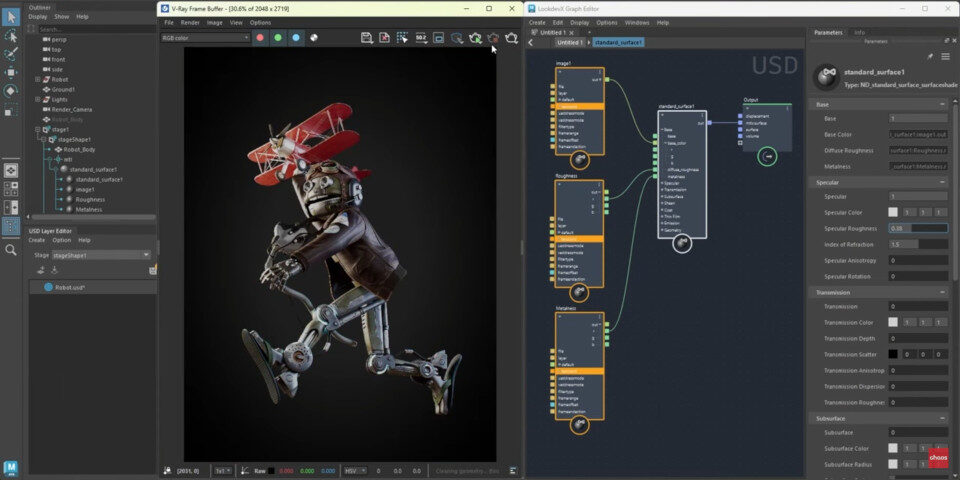Chaos releases V-Ray 6 for Maya Update 2

Originally posted on 23 May 2023 for Update 1. Scroll down for news of Update 2.
Chaos has updated V-Ray 6 for Maya, the Maya edition of the production renderer.
V-Ray 6 for Maya Update 1 adds new object scattering and instancing tool Chaos Scatter, integrates Intel’s Open Path Guiding library, and extends V-Ray GPU and USD workflows.
V-Ray 6 for Maya Update 2 adds support for MaterialX, and makes it possible to scatter lights as well as geometry using Chaos Scatter.
Chaos Scatter now available with V-Ray for Maya
New features in Update 1 include Chaos Scatter, the standalone object scattering and instancing tool first released with Corona 8 last year, and later included with V-Ray 6 for 3ds Max.
Objects can be distributed along curves, across surfaces, and within bounding boxes, providing a range of ways to populate scenes with objects, particularly vegetation.
Initial integration of Intel’s Open Path Guiding library
Another new feature – albeit still an experimental one – is support for path guiding via Open PGL, Intel’s Open Path Guiding Library.
The library, also recently integrated into Blender 3.4, prioritises light paths that interact with surfaces in the scene, helping a render to resolve to an acceptably low level of noise more quickly.
Path guiding is available when using Light Cache GI, and supports diffuse and specular sampling, and environment fog.
Other new CPU rendering features
Other new features include the Bump2Glossiness node, which generates a reflection glossiness texture from a bump or normal map, and which is intended to stop materials like skin from looking too shiny when seen at a distance.
The update also adds attenuation controls for custom Light Decay patterns, and support for emissive materials in the VRayLightMix and VRayLightSelect render elements.
In addition, the Denoiser now supports Nvidia’s AI-based upscaling technology when using the NVIDIA denoising engine.
New features supported in V-Ray GPU and USD workflows
V-Ray GPU, the software’s hybrid CPU/GPU render engine, gets a new Compressed Textures mode to reduce memory footprint, and support for RAW render elements.
Support for USD workflows has been further extended, with USD supported features now including render settings, V-Ray object properties, V-Ray Proxy and the V-Ray Dome Camera.
Performance and workflow improvements
For troubleshooting performance bottlenecks, the V-Ray Profiler gets support for profiling export tasks, and a new System mode, intended for use with simpler scenes.
Performance improvements include faster geometry compilation for static meshes, faster hair rendering, and faster loading of Alembic files.
Updated 19 February 2024: Chaos has released V-Ray 6 for Maya Update 2.
The update adds support for open material standard MaterialX, now widely adopted in other DCC applications and renderers.
The new VRayMaterialX material makes it possible to import and render materials in .mtlx format, while a new export tool makes it possible to export native V-Ray materials to .mtlx.
The update also brings initial support for LookdevX, the new toolset for authoring USD shading graphs introduced in Maya 2024.
V-Ray materials are now represented as MaterialX nodes within LookdevX, and edits can be previewed in V-Ray IPR.
Chaos Scatter can now scatter lights and object groups
Update 2 also extends Chaos Scatter, which can now scatter lights as well as geometry.
Other changes include the option to scatter groups of objects as well as individual objects; and new include and exclude lists for finer control over where objects are scattered.
Updates to Shadow Select, the V-Ray Frame Buffer, and V-Ray GPU
Updates to other existing features include new Direct Diffuse and Direct Specular render elements in Shadow Select, support for cylindrical projection in VRayDecal, and support for chromatic aberration as a post effect in the V-Ray Frame Buffer.
V-Ray GPU now supports geometry replication system V-Ray Enmesh.
Price and system requirements
V-Ray 6 for Maya Update 2 is compatible with Maya 2020+, running on 64-bit Windows 8.1+, RHEL and CentOS 7.3+ Linux and macOS 10.13+. Find detailed system requirements here.
The software is rental-only, with node-locked V-Ray Solo subscriptions priced at $466.80/year, and floating V-Ray Premium subscriptions priced at $694.80/year. Find more details in this story.
Read a full list of new features in V-Ray 6 for Maya in the online release notes
Have your say on this story by following CG Channel on Facebook, Instagram and X (formerly Twitter). As well as being able to comment on stories, followers of our social media accounts can see videos we don’t post on the site itself, including making-ofs for the latest VFX movies, animations, games cinematics and motion graphics projects.
